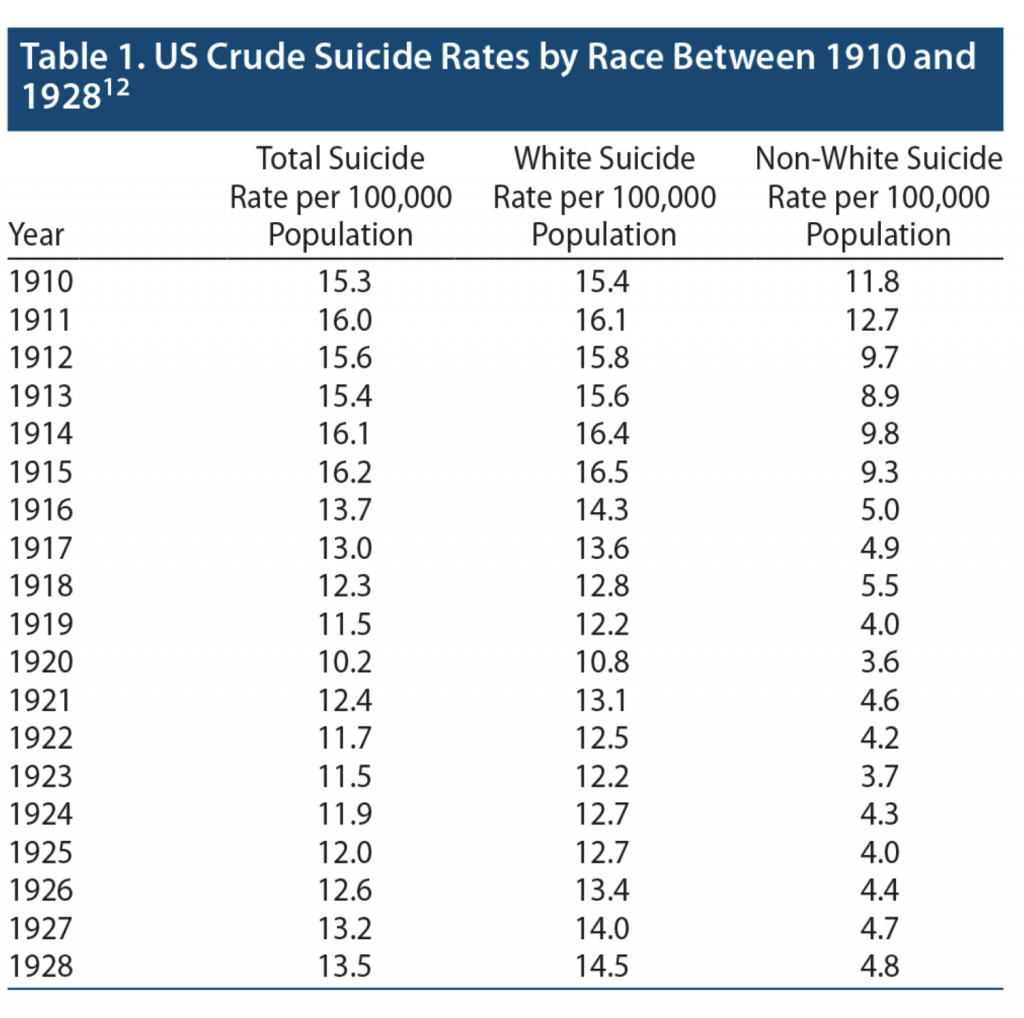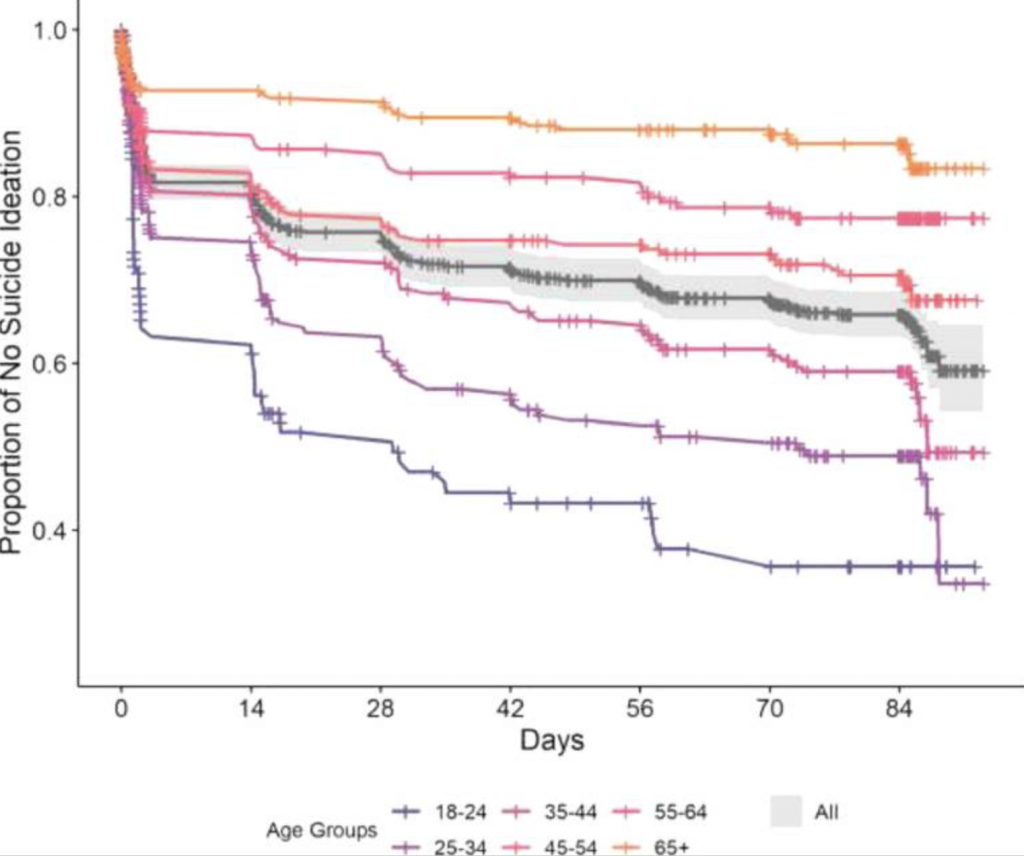“US mortality data for 2020, which estimated a 17.7% increase in overall mortality, but a 5.6% decline in US suicide rates compared to 2019”
Bastiampillai,T
The biggest leap toward helping individuals suffering from mental illnesses occurred one hundred and twenty years ago in the year 1920 when America’s first suicide prevention organization was created. (Berger) Which oddly enough was the same year that the Spanish Flu had stopped. Factors that lead to the creation of this organization varied, but most correlated with the Spanish Flu pandemic. Nevertheless, society has just begun to see the direct connection that pandemics have with mental illnesses and during the Covid-19 pandemic, the influx of information pertaining to mental illness has been limitless, which brings me to my main point. That Suicidal Ideation has been prevalent in all the pandemics dating back to 1920 and is still highly relevant today. So, what is Suicide ideation? Suicide ideation (SI) is a term that is closely connected to meaning suicidal thoughts or ideas which is used to describe a large range of mental complications and preoccupations with death and suicide.
Society in itself does a unique action during major crisis events. That action is the collective of a large majorizes of people and integration of all different backgrounds to help fight for a signal cause. This action doesn’t speak much alone, but the correlation that it has with suicide ideation and the intent to commit suicide is astonishing. The article Spanish Flu (1918-1920) Impact on US Suicide Rates by Race: Potential Future Effects of the COVID-19 Pandemic by Bastiampillai T, Allison S, Looi JCL contains reputable information about how major crisis caused suicide rates to decrease.

As we can see from the graph during years that contained major crises, the “Total Suicide Rate per 100,000” was always lower when compared to years that years with no major crisis. (Bastiampillai,T) Additionally, if that information doesn’t help you realize this very important correlation, in 2020 the US mortality rate overall had increased by 17.7%, which was primarily due to the unfortunate pandemic COVID-19; but when compared to 2019 the suicide rates decreased by 5.6% that following year. (Bastiampillai, T) Furthermore, during the first 12 weeks of the COVID-19 pandemic, the “Proportion of No Suicide Ideation” had diminished tremendously due to all the major events that occurred during those beginning months. (Batterham, P. J) Also, the occurrence of such events had another factor that affects suicide ideation and that is one’s age which can be represented in the image below.

The factor of age and suicide ideation had even occurred during other outbreaks. One notable outbreak was the 2003 severe acute respiratory syndrome coronavirus (SARS) outbreak. Two articles “Elderly suicide and the 2003 SARS epidemic in Hong Kong” and “A revisit on older adult’s suicides and Severe Acute Respiratory Syndrome (SARS) epidemic in Hong Kong reports” had written that there had been an increase in the older population at the time of the epidemic peak of the 2003 SARS outbreak. Furthermore, in the study conducted on the “Elderly suicide and the 2003 SARS epidemic in Hong Kong”, “the increase in the rates of suicide was significant for older adults (>65) but not for people under 65 in Hong Kong.” (Leaune, E) The age factor in itself is also a mystery in which why older individuals tend to have ideas of suicide ideation which leads to a suicide attempt.
Self-harm has also been another factor of great importance during COVID-19 and its connection to suicide ideation and attempts. The main risk factors that lead to the outcome of suicidal ideations “were low social support, high physical and mental exhaustion and poorer self-reported physical health in frontline medical workers, sleep disturbances, quarantine and exhaustion, loneliness, and mental health difficulties.” (Farooq, S)
Suicide and self-harm resulting from direct and indirect effects of the COVID-19 pandemic are a major public health concern
(Suicide, self-harm and suicidal ideation during COVID-19: A systematic review)
In all of the 19 studies conducted about suicide and self-harm during COVID-19, there were 79 cases of suicide and 13 cases of attempted suicide. (Farooq, S) During the study, a suicide pact between a mother and her son occurred where they ingested poisonous tablets due to an argument with the father/husband about the COVID-19 quarantine and distancing policies. (MD) Additionally, a suicide related to academic pressures was present in this study where a 15-year-old female student took her own life due to a lack of available resources to complete homeschooling. (M) This other notable factor of social ideation shows how major events can hurt individuals that one may lease expect due to a part of one’s life being ripped away without any way of being able to fight for it.
Many people including I really haven’t heard much about what suicide ideation is the factors that are a part of what suicide ideation is and how it’s directly connected to suicide attempts. But after doing an extensive amount of research on this mental illness, I hope we have been able to achieve a greater understanding of how age, life situations, and worldwide events can all tie back to one’s mental well-being. So I plead with you if you or anyone you know needs help with their mental health and well-being has destroyed or isn’t in a good state, talk to them and get them help because most likely that person will be on a direct decline towards the possibility of having thoughts pertaining to suicide ideation.
Works Cited.
Bastiampillai, T., Allison, S., & Looi, J. C. L. (2021, December 21). Spanish flu (1918–1920) impact on US suicide rates by race: Potential future effects of the COVID-19 pandemic. Psychiatrist.com. Retrieved May 3, 2022, from https://www.psychiatrist.com/pcc/covid-19/spanish-flu-impact-suicide-race-future-effects-covid-19/
Batterham, P. J., Calear, A. L., Shou, Y., Farrer, L. M., Gulliver, A., McCallum, S. M., & Dawel, A. (2022, March 1). Effects of the COVID-19 pandemic on Suicidal Ideation in a representative Australian population sample-longitudinal cohort study. Journal of affective disorders. Retrieved May 3, 2022, from https://www.ncbi.nlm.nih.gov/pmc/articles/PMC8735855/#bib0016
Berger, K. (2020, May 11). Seattle struggled with suicide in late stages of the 1918 flu. Crosscut. Retrieved May 3, 2022, from https://crosscut.com/2020/05/seattle-struggled-suicide-late-stages-1918-flu
Chan SM;Chiu FK;Lam CW;Leung PY;Conwell Y; (n.d.). Elderly suicide and the 2003 SARS epidemic in Hong Kong. International journal of geriatric psychiatry. Retrieved May 3, 2022, from https://pubmed.ncbi.nlm.nih.gov/16416469/
c., Tunmore, J., Wajid Ali, M., & Ayub, M. (2021, December). Suicide, self-harm and suicidal ideation during COVID-19: A systematic review. Psychiatry research. Retrieved May 3, 2022, from https://www.ncbi.nlm.nih.gov/pmc/articles/PMC8495045/
Leaune, E., Samuel, M., Oh, H., Poulet, E., & Brunelin, J. (2020, December). Suicidal behaviors and ideation during emerging viral disease outbreaks before the COVID-19 pandemic: A systematic rapid review. Preventive medicine. Retrieved May 3, 2022, from https://www.ncbi.nlm.nih.gov/pmc/articles/PMC7531915/#bb0125
M;, L. R. G. (n.d.). First case of student suicide in India due to the COVID-19 Education Crisis: A brief report and preventive measures. Asian journal of psychiatry. Retrieved May 3, 2022, from https://pubmed.ncbi.nlm.nih.gov/32574939/
MD;, M. M. A. C. R. M. G. (n.d.). Mother and son suicide pact due to covid-19-related online learning issues in Bangladesh: An unusual case report. International journal of mental health and addiction. Retrieved May 3, 2022, from https://pubmed.ncbi.nlm.nih.gov/32837439/
PS;, C. Y. T. C. P. H. Y. (n.d.). A revisit on older adults suicides and severe acute respiratory syndrome (SARS) epidemic in Hong Kong. International journal of geriatric psychiatry. Retrieved May 3, 2022, from https://pubmed.ncbi.nlm.nih.gov/18500689/
Saeed, F. (n.d.). PubMed. National Center for Biotechnology Information. Retrieved May 3, 2022, from https://pubmed.ncbi.nlm.nih.gov/
Image Works Cited.
Bastiampillai, T., Allison, S., & Looi, J. C. L. (2021, December 21). Spanish flu (1918–1920) impact on US suicide rates by race: Potential future effects of the COVID-19 pandemic. Psychiatrist.com. Retrieved May 3, 2022, from https://www.psychiatrist.com/pcc/covid-19/spanish-flu-impact-suicide-race-future-effects-covid-19/
Batterham, P. J., Calear, A. L., Shou, Y., Farrer, L. M., Gulliver, A., McCallum, S. M., & Dawel, A. (2022, March 1). Effects of the COVID-19 pandemic on Suicidal Ideation in a representative Australian population sample-longitudinal cohort study. Journal of affective disorders. Retrieved May 4, 2022, from https://www.ncbi.nlm.nih.gov/pmc/articles/PMC8735855/figure/fig0001/
